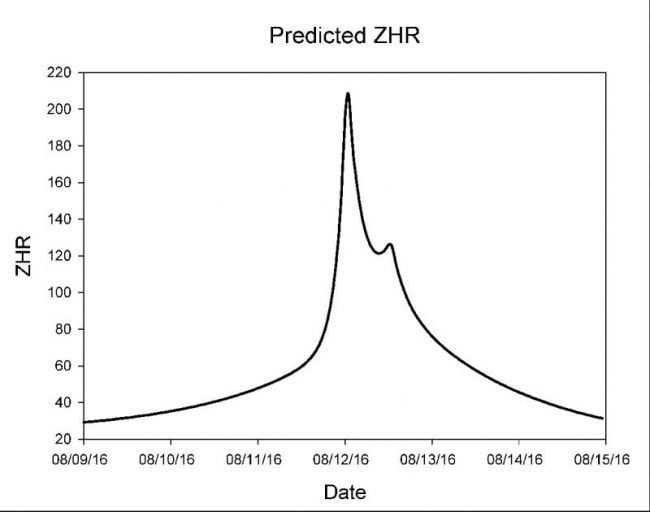The Perseid Meteor Shower Looks Even More Beautiful When You Know Where It Comes From
Each streak across the sky is a fragment of the original material of our solar system
/https://tf-cmsv2-smithsonianmag-media.s3.amazonaws.com/filer/a7/80/a7805fa5-b64b-4fea-89da-c60133fd3435/perseids3.jpg)
You probably know that August’s annual sky show, the Perseid meteor shower, is on display this week as Earth passes through a trail of debris left by Comet Swift-Tuttle. Meteors will be lighting up the night through August 24th, but the real crescendo will take place this Friday, August 12th, in the wee hours of the morning. The shower gets its name from the Perseus constellation, the cluster of stars that it appears to be radiating from.
But you might not know that the Perseids are one of about 12 annual meteor showers that we can easily observe in our skies. One of the reasons they get extra attention is because they occur during the height of summer vacation, when they are primarily visible in the northern hemisphere. (The Geminids put on the most reliable show, but only the truly dedicated stargazer is willing to stand out cold in mid-December for hours on end to see them.) The other reason has to do with the fact that Swift-Tuttle was discovered way back in 1862. “This is one of the first comets that really convinced people that there was a direct link between certain comets and meteor showers,” says James Zimbelman, a planetary geologist at Smithsonian’s National Air and Space Museum.
Each meteor shower is associated with a comet—or in rare cases, an asteroid—whose orbit brings it into the inner solar system, close enough for the sun to cause some of its ices to sublimate. Comets are like dirty snowballs, a loosely packed conglomeration of ice and dust left over from the formation of our solar system. They are believed to live en masse in a spherical reservoir called the Oort Cloud that exists at the outer limits of the sun’s gravitational influence. I say “believed” because we can’t observe such small objects directly at such great distances—comets are only .1 to 50 miles in diameter, or more than 40 times smaller than our moon. Instead, we infer the existence of the Oort Cloud based on the fact that the orbits of the comets we have observed to date suggest that they come from all directions, not just within the plane of the solar system.
The vast majority of comets spend their entire lives in a deep freeze, never making themselves known to us. But every now and then, one of them is kicked out of the Oort Cloud and sent hurtling towards the sun. Even then, the comet usually remains frozen until it gets to 2-5 AU (astronomical units, aka Earth-sun distances), where the sun’s heat is finally strong enough to transform the surface ice directly into gas. Known as sublimation, this process destabilizes pockets of dust and rocks on the surface, which are then released and strewn throughout the comet’s path—giving comets the comas and dust tails we observe. The closer the comet gets to the sun, the more active its surface is and the larger the coma and tail can grow. Some comas can extend tens of thousands or even hundreds of thousands of miles in diameter, creating debris trails orders of magnitude larger than their nuclei. Similarly, dust tails can be a long as several AU.
Not all comets display the same amount of activity during their sojourn through the inner solar system. It often depends on how many trips they’ve already made. Each orbit sublimates more and more ice, until there’s none left and the comet is nothing more than an inert assemblage of rocks and dust.
The comet that gives rise to the Perseids is Comet Swift-Tuttle, which is approximately 16 miles in diameter. It orbits the sun once every 133 years and comes within 84,000 miles of Earth (closer than the moon). Swift-Tuttle’s most recent visit to our neighborhood was in 1992, and as a result, the 1993 Perseids had a peak rate of 500 meteors per hour. The year 1992 was also then the last time its orbit was replenished with debris—the more recently a comet has passed through the inner solar system, the more dust particles it leaves in its wake (more dust particles results in a higher peak meteor rate). So in theory, we won’t see a peak that high again until 2126. But here’s the thing about orbits: They can change.

Every object in the solar system exerts a gravitational pull on every other object. The closer any two objects are and the larger the mass difference between them, the stronger this pull can be. While most comets are gravitationally bound to the sun, their orbits sometimes take them dangerously close to Jupiter, close enough for those orbits to change ever so slightly. Computer simulations have shown that this might have happened not to Swift-Tuttle itself, but to its debris trail, nudging it ever so slightly closer to Earth. It’s possible that this nudge could be enough to cause a peak rate close to 200 meteors per hour, a peak which is predicted to take place in the early, early morning of August 12th.
So wherever you happen to be this week, get outside in the hopes of catching some of the show. Each meteor you see streaking across the sky this week is a fragment of the original material of our solar system, our planet and our selves were made from. Peak or no peak, meteors are a beautiful sight and reminder of the wonder of the universe.
Related: Look Up! The Perseid Meteor Shower Is Going to Be a Doozy This Year

